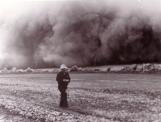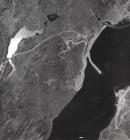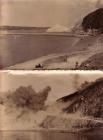15
METHOD OF QUARRYING ROCK - Blasting at Cape Porcupine was carried out using coyote holes. This method allowed a great deal of fill to be created in one blast, meaning fewer blasts were needed. Harry MacKenzie, resident engineer for O.J. McCulloch, explained in an interview with Cape Breton's Magazine how the method works."They put coyote holes in. That's a hole about 4 or 5 feet high, about the same width - and used to go in about 100 feet into the face of the mountain. Then, at the 100-foot mark they'd branch off, 50 feet each way. Then come out at the 50-foot mark and do the same thing. Then they'd load that whole thing up with dynamite and they'd bring down, oh, 350 to 400 thousand tons in one shot."
Pictured here is the view out of a coyote hole. The lines running along the tunnel's floor would connect to the charge. The tunnel entrance would be filled before blasting.
16
Blast at Cape Porcupine as worker walks along newly constructed Canso Causeway1953
Canso Causeway work site

17
BLASTING AT PORCUPINE - Harry MacKenzie, resident engineer on the construction of the Canso Causeway and Canal, told Cape Breton's Magazine's Ron Caplan that when a blast occurred at the site, the face of the mountain was reshaped, as the entire surface would fall."On a day when they were going to blast, they hauled everything out of that quarry. The whole face came out. The coyote holes are dug only on the lower level. And the whole thing, 400 foot lift of rock, just lift the whole thing and it would all come down." (Interview in 1980)
19
TRACKING AMOUNTS USED - Every load of stone dumped into the Strait of Canso for the causeway project crossed over one of two scales on site.In the top picture a crew installs one of the two 100-ton Howe truck scales that was located on the road from the quarries to the causeway in Auld's Cove. The scales were essential to keep a count on total rock dumped, so that project engineers could find a percentage of completion for the project. This monitored materials as work progressed, resident engineer for O.J. McCulloch, Harry MacKenzie, explained in an interview with Cape Breton's Magazine, years after project completion:
"My job was to see that the proper stuff was put in. We kept a record. It was figured in tons. Everything that went out there went out over those scales. There were 10,092,069 tons of rock put in that causeway.
"You took the run of the mine [for dumping], whatever we got there. That was beautiful stuff for that purpose. It wasn't good for anything else. You know, you couldn't quarry it to make it for tombstones or building rock - too many seams in it - but it was ideal for the Causeway."
The bottom picture shows an Euclid truck on the scale while the scale operator takes the measurement.
21
DANGEROUS WORK - Allister MacAskill of Auld's Cove, a Nova Scotian who worked for Northern Construction and J.W. Stewart Ltd. during construction of the Canso Causeway said that he often saw men leave after just one day on the job site. When they saw the height of Porcupine Mountain and realized the extent of the work, they said, "You won't see me back tomorrow. "It was dangerous work. He and his partner were caught in a coyote hole once by a rock slide. Fifty five year old George White was killed at Cape Porcupine on the construction of the Causeway in February of 1954 and twenty year old Joseph Ryan on his first day at work at the Canal site in June 1954.
23
DRIFT ICE CAUSED PROBLEMS - The huge drift ice came down from the Gulf of St. Lawrence every winter into the Strait of Canso and jammed the area from mainland Nova Scotia to Cape Breton Island shores at times. It would shift back and forth with the tides. This created problems to the automobile and train ferries that crossed between Mulgrave and Point Tupper and Mulgrave and Port Hawkesbury causing serious delays.After the construction of the Canso Causeway, the ice was stopped on the north side of the Canso Causeway.
25
COYOTE BLASTING - In an October, 1953, Imperial Oilways Magazine stated that "coyote blasting" wasn't often used in construction work at the time "...this method results in muck in which large, heavy chunks of rock predominate, which in turn leads to a compact, dense type of fill admirably suited to the requirements of a causeway in a tidal ocean. It also provides large quantities of muck quickly, so that Northern is presently running slightly ahead of its schedule, blasting and filling slightly under 400,000 tons of material a month."27
Canso Causeway construction aerial view showing Cape Porcupine quarry.1953
Cape Porcupine, Auld's Cove, Nova Scotia, Canada






